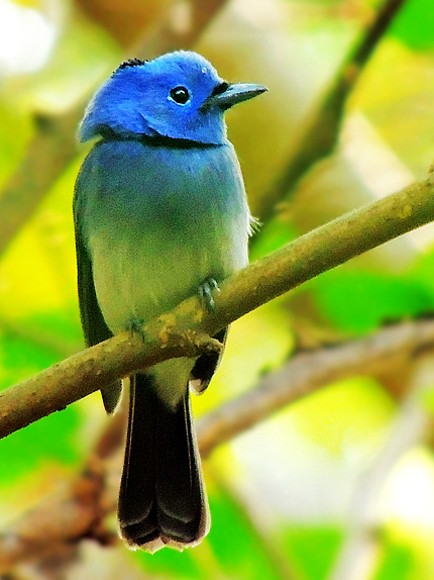Black-naped Monarch
A species of Blue Monarchs Scientific name : Hypothymis azurea Genus : Blue Monarchs
Black-naped Monarch, A species of Blue Monarchs
Botanical name: Hypothymis azurea
Genus: Blue Monarchs
Content
Description General Info
 Photo By Shantanu Kuveskar , used under CC-BY-SA-4.0 /Cropped and compressed from original
Photo By Shantanu Kuveskar , used under CC-BY-SA-4.0 /Cropped and compressed from original Description
The adult male black-naped monarch is about 16 cm long, and is mainly pale azure blue apart from a whitish lower belly. It has a black nape and a narrow black gorget. The female is duller and lacks the black markings. Its wings and back are grey-brown. However, several geographically separated breeding populations differ in the extent and shade of markings. The Indian peninsula has subspecies H. a. styani (which subsumes H. a. sykesi of Stuart Baker), in which males have very distinct black markings and a whitish abdomen. Males of the Sri Lankan race H. a. ceylonensis lack the black nape and gorget and the shade is more purplish. The subspecies of the Andaman Islands, H. a. tytleri, has the underparts blue grey. The form on Car Nicobar Island, H. a. idiochroa, has a greyish white belly, while H. a. nicobarica from the southern Nicobars has a smaller and finer bill. The colour of the gape is yellowish to green. 
Size
17 cm
Colors
Brown
Gray
White
Blue
Nest Placement
Tree
Feeding Habits
Black-naped Monarch primarily consumes insects, using flycatching techniques to capture its prey. This bird distinguishes itself with specialized hunting behavior, often foraging during specific times that optimize its insect prey availability.
Habitat
Black-naped Monarch primarily inhabits tropical broadleaf evergreen forests, including semi-evergreen and deciduous forests, as well as peatswamp forests. These birds are found in well-wooded regions, encompassing secondary growth and overgrown plantations with heavy foliage often near streams. Bamboo-rich areas are also favored within their habitat. They occupy a wide altitude range, from sea level to approximately 1500 meters, and can be found within this range across various tropical regions of southern Asia.
Dite type
Insectivorous
General Info
Feeding Habits
Bird food type
Bird Feeder Type

Platform
Behavior
The black-naped monarch has short legs and sits very upright whilst perched prominently, like a shrike. It is insectivorous, often hunting by flycatching. When alarmed or alert, the nape feathers are raised into a pointed crest. They join mixed-species foraging flocks, being among the most significant members of such flocks in the Western Ghats, and are active in the understory of forest canopies. A study in Sri Lanka showed that they are affected by human disturbance causing them to recede from disturbed edges by about 75 m. Although they are largely residents, local seasonal movements are known. The breeding season in India is March to August and the nest is a neat cup placed in a fork. The cup is lined with filaments of webbing and fungi including those of the genus Marasmius which are known to produce antibiotics and may benefit the birds by protecting the young from infection. The nest is built by the female while the male guards. The typical clutch is three eggs, which both parents incubate and both feed the young, which hatch after about 12 days. The webs of large spiders such as Nephila maculata have been known to trap the bird. An astrovirus was detected in a black-naped monarch in Cambodia, a virus that was earlier unknown from passerines. The feather mite Proterothrix hypothymis (Pterodectinae: Protophyllodidae) has been described from black-naped monarchs in Vietnam. 
Distribution Area
The black-naped monarch breeds across tropical southern Asia from India and Sri Lanka east to Indonesia and the Philippines. This species is usually found in thick forests and other well-wooded habitats. The calls are a sharp and abrupt skrip. The main breeding season in India is in summer from May to July. Two to three eggs are laid in a cup nest placed in the fork of a tree. The nest is decorated with spider-egg cases. 
Species Status
Not globally threatened.
Scientific Classification
Phylum
Chordates Class
Birds Order
Perching birds Family
Monarchs Genus
Blue Monarchs Species
Black-naped Monarch